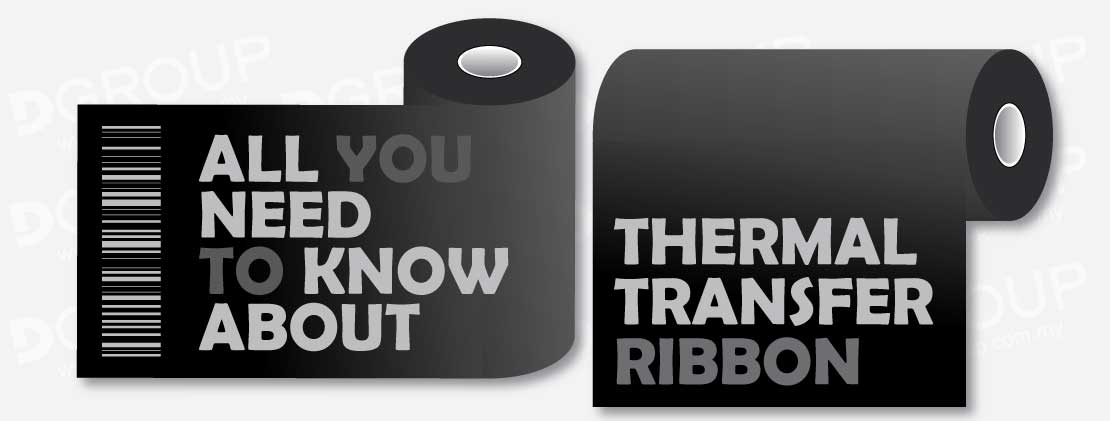
ALL YOU NEED TO KNOW ABOUT THERMAL TRANSFER RIBBON
Article by Nicholas. Edited by Blue. Updated April 30, 2025
"GREAT THINGS COME IN PAIRS"
This saying illustrates how two different things go well together. We have great pairs like peanut butter and jam, salt and pepper, pen and paper, nuts and bolt, needle and thread.
Similarly, the label material needs to find its suitable pair of thermal transfer ribbon (TTR). A mismatch would spell disaster – text will be blurry, barcode not scannable, and printing can easily smear.
Before we jump into the right pairing, let's find out what a thermal transfer ribbon is.
WHAT IS A THERMAL TRANSFER RIBBON (TTR)?
A TTR is a roll of clear plastic (PE) film with one side being ink coated. It is also known as barcode ribbon - as it often used for printing barcodes onto price tags.
When placed inside the thermal printer, the ink is transferred by heat, forming text or images onto the label.
On a side note, there are thermal printers which do not use ribbons. It utilises specialised label that already has ink embedded within it, called the thermal label.
LAYERS IN TTR
As thin as a thermal transfer ribbon may seem, it is actually made up of four layers!
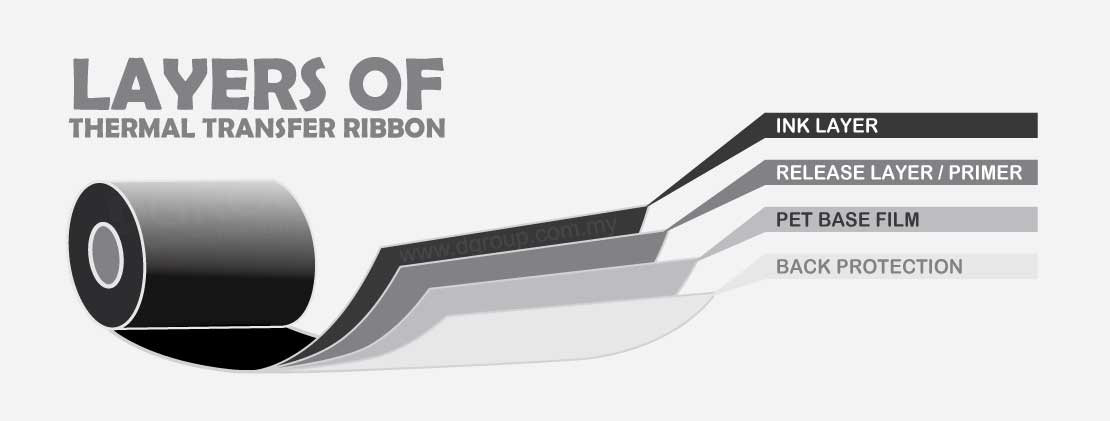
Each layer has its unique features to ensure the highest quality of images formed on the label.
- Ink Layer has ink coated on it. Upon receiving heat, the ink is transferred and generates an image onto the label surface.
- Release Layer / Primer facilitates the release of ink from PET base film.
- PET Base Film Layer bridges the heat from the printerhead to the ink layer.
- Back Protection Layer protects both PET base film and printerhead by reducing static electricity & excessive friction issues.
TYPES OF TTR
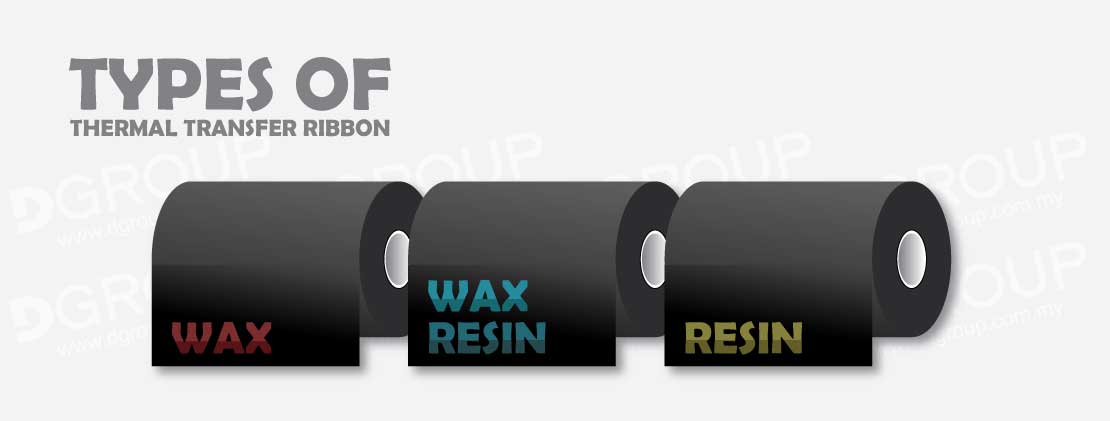
The pairing of a label with the correct type of TTR is important. TTR comes in three different range of ink formulation:
(1) Wax. (2) Wax-resin. (3) Resin.
Which type of ribbon is suitable for my label? Let us look at their differences and their suitable applications.
| TYPE: | (1) WAX | (2) WAX-RESIN | (3) RESIN |
| ELEMENTS |
|
|
|
|---|---|---|---|
| TRAITS |
|
|
|
| LABEL PAIRING |
|
|
|
| COMMON USES |
|
|
|
WHICH PRINTER IS SUITABLE FOR MY TTR?
(a) THERMAL TRANSFER PRINTING METHOD
There are two types of thermal printer - direct thermal and thermal transfer.
Generally, TTR is only used on barcode printer with thermal transfer printing option. Thermal transfer printer may be more costly, but that's because it can perform both printing methods.
Yes, you can use a thermal transfer printer to do direct thermal printing too.
To understand better how thermal transfer & direct thermal technologies work, check them out in our previous article, "Thermal Transfer vs Direct Thermal”.
Are you using the right printer for your application? Does it cater for thermal transfer printing method? Do you wish to explore better options? Check out our range of barcode printers here.
(b) PRINTERHEAD TYPE
There are two different printerhead technologies – flathead and near-edge.

Most barcode printers use flathead technology - an orthodox method for thermal printing. These printers are compatible with most thermal transfer ribbons in the market. As its name suggests, the flathead printerhead lies flat against the ribbon and the label. Both ribbon and label remain in contact for a short distance as they are passed through the heating area, before their eventual separation.
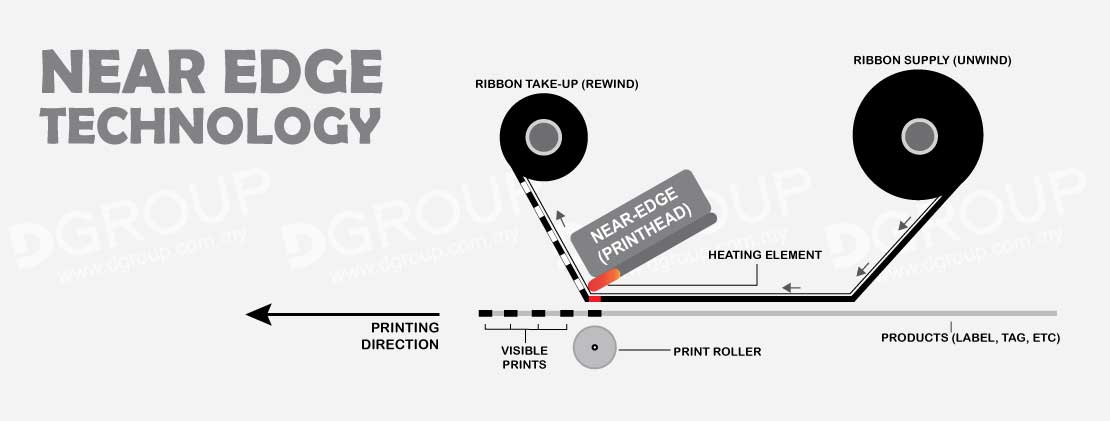
Barcode printers with near-edge technology however uses specially formulated TTR. Its 45 degrees angled printerhead allows rapid speed printing at rates much higher than flathead technology. The ribbons are specially made to release ink immediately upon brief contact with the heating element, making the printing process much speedier. Near-edge printer models includes TOSHIBA B-SX4 and B-EX4T1. If you are using near-edge printer, you need to choose ribbons formulated for near-edge technology.
Note: Using a flathead ribbon in a near-edge printer or vice-versa would not produce the proper texts/images on your labels. They could be unclear & smeared off easily. The printing will be blurry, & incomplete too.
What happens when wrong ribbons are purchased?
Most users would increase the printerhead temperature in attempt to improve on the print quality. This action however, is done at the expense of your printerhead’s lifespan.
Printerheads cost much more than ribbons. You do the math.
So yes, always match the right ribbon for the right printer.
(c) INK CONFIGURATION
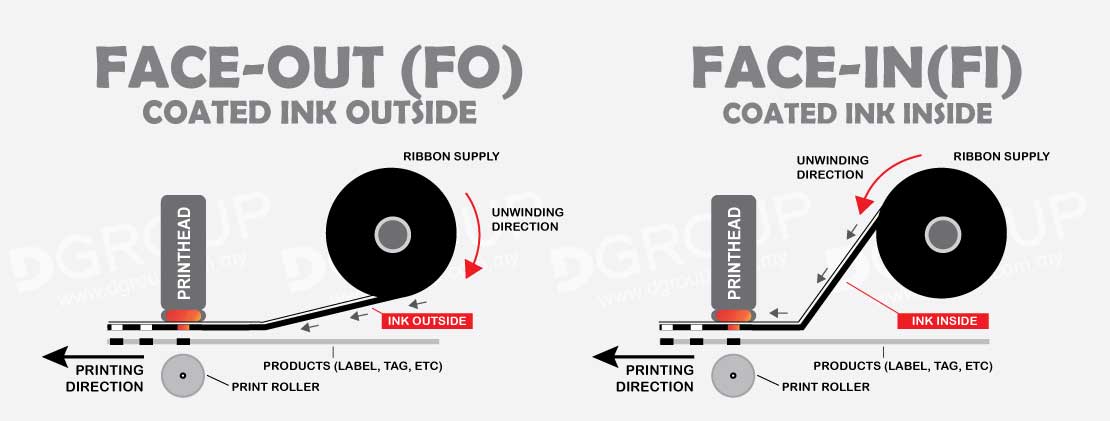
In a rolled form, the ink of thermal transfer ribbons is either coated outside or coated inside.
If the ink is on the outer layer, it is known as coated side out, ink outside, or face-out (FO).
Likewise, if the ink is in the inner layer, it is known as coated side in, ink inside, or face-in (FI).
Different brands and models of barcode printers may require either one of the configurations. Very rarely a model is able to cater for both ink setups.
If you choose the wrong configuration; ribbon coated side out (FO) but thermal printer require ink coated side in (FI) or vise verse, no printing can be produced. Worse, it may damage the printerhead.
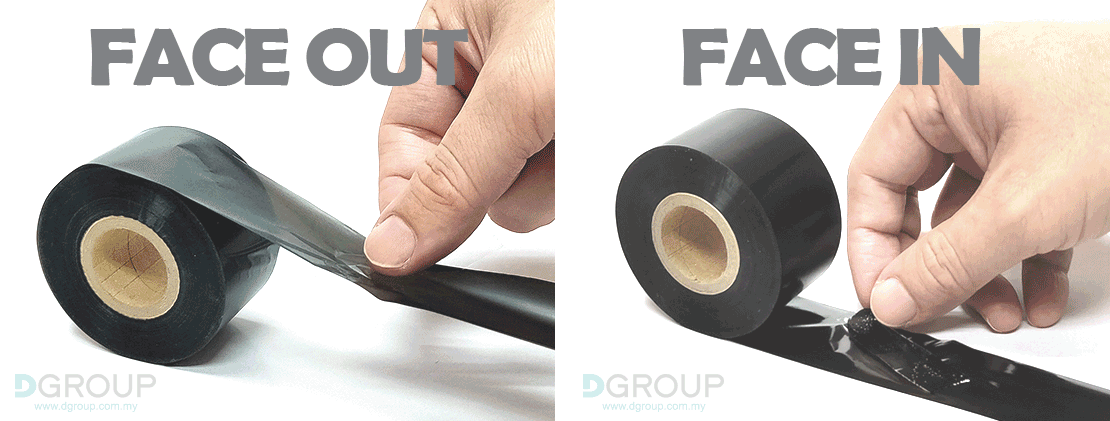
You can determine your current ribbon set up with a simple test.
Simply paste a tape on the outer layer. When you peel the tape off, observe if the ink sticks to the tape. If it does, then the ink is coated outside (FO).
If it doesn’t, stick the tape to the inner layer. If the inner layer ink comes off, the ribbon is coated inside (FI).
FREQUENTLY ASKED QUESTION - FAQ
1) What is the lifespan of your thermal transfer ribbon when not in use? How do you ensure its longevity?
Thermal transfer ribbon can last up to approximately 24 months (2 years). This is only possible if it is kept indoors at room temperature. Do not expose it to places with high humidity, direct sunlight, or other harsh conditions.
2) Are thermal transfer ribbons only available in black colour?
Black thermal transfer ribbon makes up 85-90% of the market. While it is in high demand and commonly used, there are also white, red, blue and other coloured ones.
3) What is the right ribbon size for my label?
The ribbon is not sized the same as a label. There are three important factors you need to keep in mind:
(i) Width - The ribbon width must be closest to but wider than the label width. For example, if your label width is 38mm, you would want to choose a 40mm ribbon width. With this, you are providing enough space for the ink to fully form your desired image on the label while minimizing the amount of unused ink. Plus, a ribbon width that extends past the edge of the label would also prevent damaging the printerhead made by the label.
(ii) Length - Generally, ribbon length depends on the thermal printer’s capacity. Depending on the model type, the desktop thermal printer able to fit 70 meter, 90 meter, 100 meter or 300 meter ribbon. Industrial printers have larger capacity to fit 300 meter, 450 meter, 600 meter and 900 meter. Larger ribbon capacity means less time is wasted on changing out ribbons between print jobs, maximizing efficiency.
(iii) Core size - The ribbon core size is determined by the printer’s model. The printer can either fits 0.5” core or 1” core. There are newer printer models which can cater to both sizes.
4) Is my thermal transfer ribbon coated side in (FI) or coated out (FO)?
To determine this, simply stick a piece of tape on the outside of your ribbon roll.
Peel it off. If the ink sticks to the tape, your ribbon is coated side out (FO).
If the ink does not stick, the ribbon is coated side in (FI).
5) Must I match my ribbon for my printer based on the brand?
All the ribbons supplied came from the same sources, regardless of their brands. Hence, you do not need to match them with your printer based on their brands. For example, Zebra ribbon is not made to be used solely on Zebra printer. Likewise, TSC ribbon is not made for TSC printers only. They are all similar. The matching depends on the ribbon type, ink coating side, and core size. Ribbons, however, may differ in terms of qualities. Of course, the best ribbons are most compatible with your labels and produce the best quality printing for your application.
Contact us for assistance and any enquiry on customised thermal transfer ribbon.